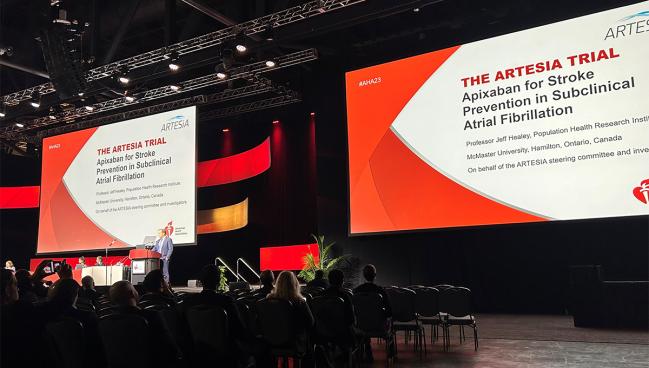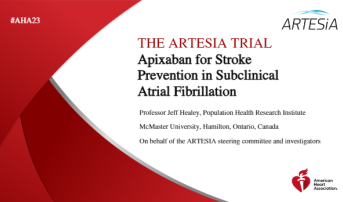ARTESiA: Apixaban Lowers Stroke Risk in Subclinical AF
(UPDATED) With an increase in major bleeding, too, there’s a question about whether the benefit is worth the risk.

PHILADELPHIA, PA—In patients with subclinical atrial fibrillation (AF) detected with an implantable device, apixaban (Eliquis; Bristol Myers Squibb) lowers the risk of stroke or systemic embolism compared with aspirin, although that comes at the cost of more major bleeding, according to the ARTESiA trial.
Rates of stroke or systemic embolism were low overall, but risk was reduced by an absolute 0.46% with apixaban. At the same time, ISTH major bleeding was increased by an absolute 0.77%, Jeff Healey, MD (Population Health Research Institute, McMaster University, Hamilton, Canada), reported here at the American Heart Association 2023 Scientific Sessions.
Providing some nuance to those findings, Healey noted that apixaban, on the efficacy side, reduced the risk of permanently disabling or fatal strokes relative to aspirin and, on the safety side, didn’t increase fatal or intracranial bleeding.
Considering the balance of risks and benefits, he concluded that “anticoagulation should be considered among patients with subclinical atrial fibrillation who have additional stroke risk factors.”
Commenting for TCTMD, Luigi Di Biase, MD, PhD (Albert Einstein College of Medicine at Montefiore Hospital, Bronx, NY), said “the trial goes into the direction that, yes, we should put these patients on a medication.”
But it also raises questions about whether alternative approaches that potentially carry lower bleeding risks—like left atrial appendage occlusion—could be useful as well, said Di Biase, a member of the American College of Cardiology’s electrophysiology section.
Nevertheless, ARTESiA is a positive trial, and the findings should be taken into consideration when managing patients with subclinical AF, especially since 24% of participants in the study converted to open-label anticoagulation due to developing device-detected bouts of AF lasting more than 24 hours or clinical AF.
“I think these patients will need treatment,” he said. “If anticoagulation is the solution or if we can think about something different needs to be probably established, but as of today, I think anticoagulation with a [direct oral anticoagulant], in this case apixaban, will need to be given to the patient.”
The findings were published simultaneously online in the New England Journal of Medicine.
The ARTESiA Trial
Subclinical AF—brief bouts detected on a device capable of long-term continuous arrhythmia monitoring—has been found in about one-third of patients with a pacemaker or implantable cardioverter-defibrillator (ICD) and has been associated with about a 2.5-fold greater risk of stroke in prior studies. That’s less than the magnitude of the increased stroke risk associated with clinical AF (about 4.5-fold), so there has been an open question about whether oral anticoagulation should be used in response to subclinical AF.
ARTESiA, conducted at 247 centers in 16 countries, aimed to answer that question, enrolling 4,012 patients (mean age 76.8 years; 36.1% women) with subclinical AF episodes lasting 6 minutes to 24 hours on an implanted pacemaker, defibrillator, or cardiac monitor plus one of the following factors: age ≥ 55 plus a CHA2DS2-VASc score ≥ 3, age ≥ 75, or a history of stroke. They were randomized to apixaban 5 mg twice daily (or a half dose if they met labeled criteria) or aspirin 81 mg/day.
At baseline, the mean CHA2DS2-VASc score was 3.9. Roughly two-thirds of patients were taking antiplatelet therapy. The mean longest episode of subclinical AF over the prior 6 months was about 1.5 hours.
Patients were followed for a mean of 3.5 years, and over that span, apixaban reduced the risk of stroke or systemic embolism in an intention-to-treat (ITT) analysis (HR 0.63; 95% CI 0.45-0.88) and increased the risk of ISTH major bleeding in an on-treatment analysis (HR 1.80; 95% CI 1.26-2.57). The risk of major bleeding also remained greater in the ITT population (HR 1.36; 95% CI 1.01-1.82).
Healey presented a risk-benefit analysis showing that there would be 4.6 fewer strokes or systemic emboli and 4.1 more major bleeding per 1,000 patient-years with apixaban versus aspirin.
He noted that 45% of strokes in aspirin-treated patients were permanently disabling or fatal, and that this type of stroke was reduced with apixaban (0.27% vs 0.53%; HR 0.51; 95% CI 0.29-0.88). In terms of major bleeds, he said only 20% of those that occurred in apixaban-treated patients were associated with hemodynamic instability or neurological symptoms.
There was no difference between the apixaban and aspirin groups in all-cause death (5.06% vs 4.82%; HR 1.04; 95% CI 0.90-1.21) or CV death (1.47% vs 1.53%; HR 0.96; 95% CI 0.73-1.25).
Weighing the Benefits and the Risks
Discussing the results at a press conference, Christine Albert, MD (Smidt Heart Institute at Cedars-Sinai, Los Angeles, CA), who was not involved in the study, underscored its importance by noting that there is currently no guideline recommendation to use oral anticoagulation or aspirin in patients with subclinical AF detected on an implantable device.
This is the first well-powered, long-term trial to explore the impact of anticoagulation in this scenario, showing a clear reduction in stroke or systemic embolism and an increase in bleeding with apixaban versus aspirin, she said, providing context to the latter finding by noting that aspirin itself carries risks of bleeding.
The trial showed that even though the risk of stroke is reduced with apixaban, rates were very low in both groups, Albert pointed out.
“I believe that this trial really does show that oral anticoagulation reduces the risk of stroke and systemic embolism,” she said. “The question is: is that worth it for the bleeding risk? And that’s what I think we’re going to have to discuss.”
In her formal discussion following Healey’s full presentation, Albert noted that the number needed to harm based on the difference in major bleeding between apixaban and aspirin (130) was lower than the number needed to treat to prevent one stroke or systemic embolism (250).
“Given the risk-benefit ratio, there needs to be some pause and further consideration by our expert guideline committees before implementing this therapy in patients with [subclinical AF lasting] less than 24 hours,” she concluded.
“That doesn’t mean that there wouldn’t be subsets that I think would benefit, but I’m not sure that I would do a blanket introduction of this,” Albert said during the press conference. “I think we need to think a little bit more about those risks and benefits for an individual patient.”
Panelists during the main presentation also expressed some hesitation about treating the types of patients included in ARTESiA.
Jose Joglar, MD (UT Southwestern Medical Center, Dallas, TX), highlighted the low overall stroke rate and suggested that anticoagulation might be more useful in patients with higher CHA2DS2-VASc scores, which would have to be tested in future trials. As for whether he’ll be implementing the ARTESiA findings in his practice? “Not yet,” he said.
Similarly, Manesh Patel, MD (Duke University, Durham, NC), said “likely not” when asked the same question. “The only thing that will move me will be, likely, if there’s a high risk or some other driver,” he said, noting that there are still many patients with clinical AF who go untreated and represent an area of opportunity when it comes to anticoagulation.
Elaine Hylek, MD (Boston Medical Center, MA), had a bit of a different view, however, questioning whether the stroke risk observed in ARTESiA should be discounted. “I think it’s a tough question,” she said. “No one wants to have bleeding because that’s when patients stop these agents, but I would just challenge that 1% is just too low to be thinking about treatment because I think one in a hundred isn’t trivial.”
Todd Neale is the Associate News Editor for TCTMD and a Senior Medical Journalist. He got his start in journalism at …
Read Full BioSources
Healey JS, Lopes RD, Granger CB, et al. Apixaban for stroke prevention in subclinical atrial fibrillation. N Engl J Med. 2023;Epub ahead of print.
Disclosures
- ARTESiA is supported by grants from the Canadian Institutes of Health Research, the Bristol Myers Squibb–Pfizer Alliance, the Heart and Stroke Foundation of Canada, the Canadian Stroke Prevention Intervention Network, Hamilton Health Sciences, the Accelerating Clinical Trials Network, the Population Health Research Institute, and Medtronic.





Comments